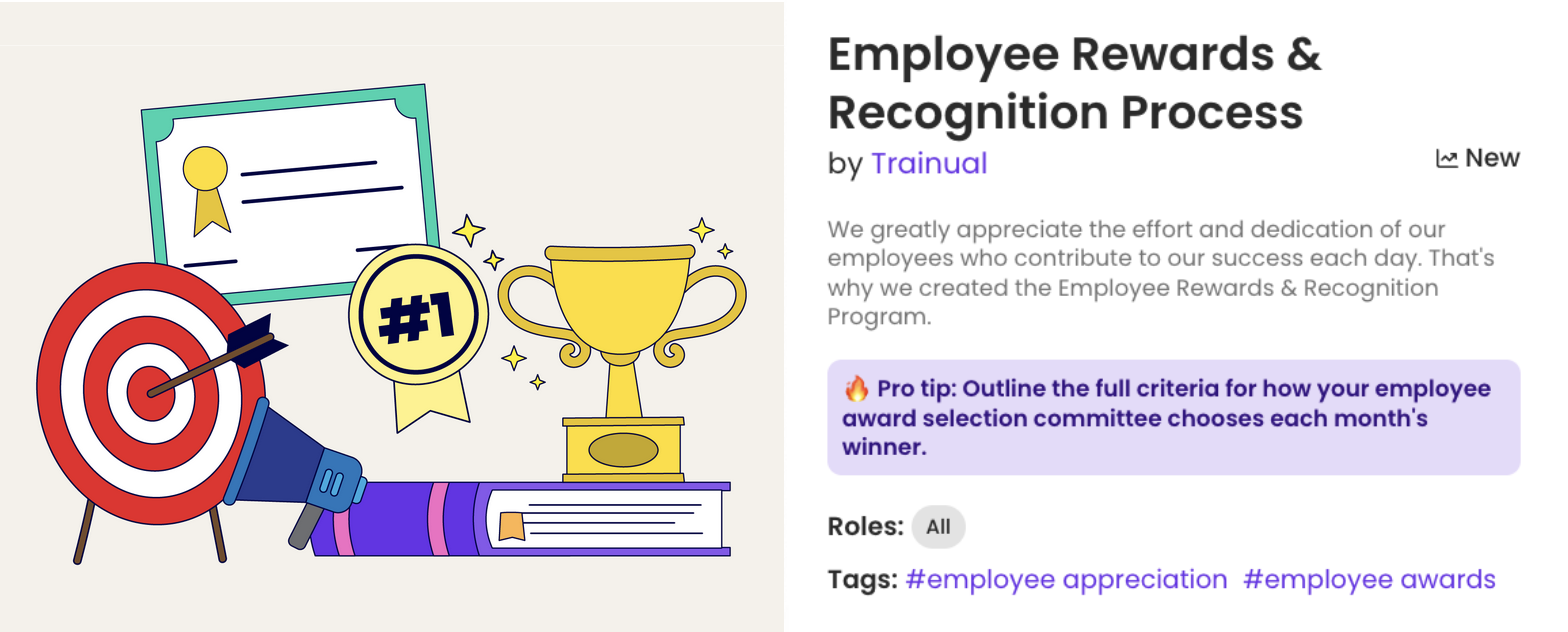Here are the (massive) benefits of gratitude and employee recognition
November 22, 2023

Hot off the SMB press this week:
- A template to set up an employee recognition program.
- How knowing your problem-solver profile can make decision-making better for you and your team.
- Why Trainual is a great asset for your employees’ performance evaluations.
- A Thanksgiving treat: 3 unique things you may not know about gratitude.
STARTER PACK
Template of the week: Employee Rewards & Recognition Process

If you woke up tomorrow and only had the employees you thanked today, how many employees would you have? Okay, okay, we’ll stop getting all philosophical on you. But in the spirit of giving thanks this week, we wanted to remind you how important it is to show your employees recognition for their hard work, dedication, and outstanding performance (and give them a reason to keep it up!).
A great way to show your team you see them is a rewards and recognition process. (And before you say no, don’t worry — you don’t have to pull an Oprah and offer everyone a new car to tell them thank you.)
It can be as simple as a quarterly gift card, a dedicated parking spot, or even a certificate or small trophy — presented in front of the whole team. Your employees will count down the days until nominations and announcements — anticipating the day they’ll be publicly recognized and singing praises for their peers along the way.
👉 Need to establish a process to hype up your team? Get started with our Employee Rewards & Recognition Process template. It contains starter content for everything about rewards and recognition at your company — like why you have rewards, who’s eligible for rewards, and how awards are selected and presented. Stick it straight in your Trainual account, adjust as needed, and share it with your team to get them inspired for the next rewards period ASAP!
Want more templates to help you build your business playbook? Check out our entire template archive of free, multimedia-enhanced, and customizable policy, process, and role starters. New to Trainual? Get a demo.
DECISIONS, DECISIONS…
Which of the five problem-solver profiles (PSPs) do you use to make decisions?
What are problem-solver profiles?
There are five problem-solver profiles (PSPs) identified by Cheryl Einhorn, researcher and founder of decision sciences company Decisive. PSPs explain how people tend to approach their decisions. They include:
- Adventurers. This profile goes with their gut (making decisions easily), but they tend to ignore evidence and input from others if it goes against their instincts.
- Detectives. Basically the opposite of the adventurers, this profile follows data and facts. However, as a result, they can undervalue people.
- Listeners. These problem-solvers put a lot of weight on others’ input. The downside is this can cause them to ignore their own voice.
- Thinkers. This type tends to identify multiple possible journeys to the solution. As a result, they can struggle to make timely decisions.
- Visionaries. Much like your typical business owner, this type sees none other than the road not yet traveled to solve the problem. However, they can be so fixated on their new ideas that they overlook simple (but effective) solutions.
Which one do you see in yourself? And more importantly, what’s your biggest decision-making blind spot?
Here’s what to do when your go-to problem-solving approach fails:

Ask yourself these eight questions to identify what’s influencing your decision-making and improve your collaborative decision-making skills:
1. What’s the problem?
We often communicate and make decisions in ways that are comfortable for us, even though a different approach would still get us the results we’re looking for. So ask yourself: What’s the negative experience you’re having at work that’s impacting your company (like your culture, communication, or operations), or you (your efficiency or ability to effectively carry out processes)?
2. What’s your team dynamic?
Where you work (in the office, in the field, or remotely) and your role can affect your confidence as a decision-maker. Maybe you feel best flying solo, but your team members need more collaboration (like regular meetings or partnered projects). Make sure to gather feedback from your team to understand how they work best and foster an environment of comfortability and constructive problem-solving.
TRAINUAL TIPS & TRICKS
Trainual: A tool that supports your performance reviews
Scaling your business doesn’t just come from adding more people to your team — you also grow when your company is committed to the development of your current employees. Because when you provide opportunities for your team to continuously improve, they grow in ways that make your company better.
And one of the best ways to monitor and improve your team is through performance reviews.
Whether you hold them quarterly, annually, or somewhere in-between, these evaluations provide managers the opportunity to give performance feedback and offer your employees clarity on where they can realign with company goals and develop their professional skills. And while we’re not a performance review platform, Trainual can make your evaluations a little simpler.
Not only is Trainual the best place to house your performance evaluation process (the documented process will standardize and streamline how reviews are run and give you consistency), but it also provides downloadable reports on your employees’ training progress.
Maybe your employee hasn’t completed a training that’s affecting their performance on the daily, or their test results for certain policies point to a lack of comprehension. In any scenario, these reports can tell you a lot about why your employees may be struggling — and where they can make some instant improvements before the next evaluation cycle.
👉 Jump into your employee reports now. (New to Trainual? Get a demo.)
THE SCIENCE OF GIVING THANKS
How business leaders should be thinking about gratitude

Wow, another article about gratitude.
It’s fall, which means a few things: Leaves change color, brands introduce their yearly pumpkin-spiced goods, and without fail, you’ll be bombarded with gratitude-related headlines during Thanksgiving.
And we’re jumping on the bandwagon — but we’re keeping it short and simple. Here are the three things you should know about practicing gratitude:
1. There are a lot of benefits.
Improved sleep, reduced stress, stronger relationships — these are just some of the benefits that come from practicing gratitude. In fact, a Dutch study from 2020 found that 15 minutes of daily gratitude exercises led to a marked increase in happiness amongst participants, even six months after the study had ended.
Gratitude can also increase positivity and happiness, which make it more likely for you to be successful. Plus, when you offer appreciation for your employees, it makes them feel valued, which can lead to more initiative, collaboration, and care about their work.
2. Gratitude can change how your brain works — for the better.
There’s a saying in neuroscience: “Neurons that fire together, wire together.” AKA, the more you repeat an experience or think the same thing, the easier your brain will find it to do again and again.
Meaning, the more you practice gratitude now, the easier it will be for your brain to adapt to this mindset of recognizing and expressing it. Which will then help you reap the benefits of gratitude (and as we covered, those are pretty great).




